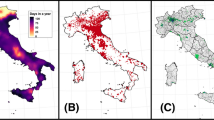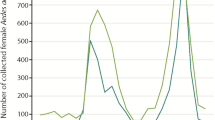Abstract
Objectives
The purpose of this study is to analyse the effect of a community participation programme based on the ecosystem model on the incidence of dengue in urban communities.
Methods
A randomized controlled field trial was conducted in the state of Colima, Mexico. The intervention consisted of a community participation programme focused on the ecosystem; simultaneously, the control groups were communities that only received the usual official prevention programs. The incidence of dengue was estimated in people of both groups due to the appearance of de novo IgM antibodies during the follow-up period.
Results
The incidence of dengue in the intervened group was 2.58%/month (n = 818) and in control group 2.26%/month (n = 994), with a risk ratio of 1.14 (95% CI 0.89–1.45) and a PAF of 0.06 (95% CI − 0.056 to 0.16). The A. aegypti larval density (Breteau Index) was reduced in the treated group.
Conclusions
The implementation of a community participation programme in the cities of Colima, Mexico, showed a slightly counterproductive effect on the incidence of dengue. This happened even with a reduction in the A. aegypti index.

Similar content being viewed by others
References
Al-Muhandis N, Hunter PR (2011) The value of educational messages embedded in a community-based approach to combat dengue Fever: a systematic review and meta-regression analysis. PLoS Negl Trop Dis 5:e1278. https://doi.org/10.1371/journal.pntd.0001278
Andersson N, Nava-Aguilera E, Arosteguí J, Morales-Perez A, Suazo-Laguna H, Legorreta-Soberanis J et al (2015) Evidence based community mobilization for dengue prevention in Nicaragua and Mexico (Camino Verde, the Green Way): cluster randomized controlled trial. BMJ 351:3257. https://doi.org/10.1136/bmj.h3267
Blacksell SD, Doust JA, Newton PN, Peacock SJ, Day NP, Dondorp AM (2006) A systematic review and meta-analysis of the diagnostic accuracy of rapid immunochromatographic assays for the detection of dengue virus IgM antibodies during acute infection. Trans R Soc Trop Med Hyg 100:775–784
Bonet M, Spiegel JM, Ibarra AM, Kouri G, Pintre A, Yassi A (2007) An integrated ecosystem approach for sustainable prevention and control of dengue in Central Havana. Int J Occup Environ Health 13:188–194
Bouzid M, Brainard J, Hooper L, Hunter PR (2016) Public Health interventions for aedes control in the time of Zika virus—a meta-review on effectiveness of vector control strategies. PLoS Negl Trop Dis 10:e0005176. https://doi.org/10.1371/journal.pntd.0005176
Carvalho MS, Honorio NA, Garcia LMT, Carvalho LCS (2017) Aedes ægypti control in urban areas: A systemic approach to a complex dynamic. PLoS Negl Trop Dis 11: e0005632. https://doi.org/10.1371/journal.pntd.0005632
Chudley E, Werch D, Owen M (2002) Iatrogenic effects of alcohol and drug prevention programs. J Stud Alcohol Drugs 63:581–590
Cromwell EA, Stoddard ST, Barker CM, Van Rie A, Messer WB, Meshnick SR, Morrison AC, Scott TW (2017) The relationship between entomological indicators of Aedes aegypti abundance and dengue virus infection. PLoS Negl Trop Dis 11:e0005429. https://doi.org/10.1371/journal.pntd.0005429
Espinoza-Gómez F, Hernández-Suárez CM, Coll-Cárdenas R (2002) Educational campaign versus malathion spraying for the control of Aedes aegypti in Colima, Mexico. J Epidemiol Community Health 56(2):148–152
Espinoza-Gómez F, Hernández-Suárez CM, Rendón-Ramírez R, Carrillo-Alvarez ML, Flores-González JC (2003) Transmisión interepidémica del dengue en la ciudad de Colima, México. Salud Publica Mex 45:365–370
Greenland S (1984) Bias in methods for deriving standardized morbidity ratio and attributable fraction estimates. Stat Med 3:131–141
Gyawali N, Taylor-Robinson AW (2016) The epidemiology of dengue infection: harnessing past experience and current knowledge to support implementation of future control strategies. J Vector Borne Dis 53:293–304
Instituto Nacional de Geografia, Estadistica e Informática. Sistema de Consulta de Integración Territorial, Entorno Urbano y Localidad. Catalogo de AGEBS por estado y municipio. INEGI (2005). Mexico. http://www3.inegi.org.mx/sistemas/scitel/consultas/index. Retrieved on May 30, 2017
Lanciotti RS, Calisher CH, Gubler DJ, Chang GJ, Vorndam A (2018) Rapid detection and typing of dengue viruses from clinical samples by using reverse transcriptase-polymerase chain reaction. J Clin Biol 30:545–551
Lebel J (2004) Ecohealth and the developing world. EcoHealth 1:325–326. https://doi.org/10.1007/s10393-004-0142-2
Lisitza A, Wolbring G (2018) Ecohealth and the determinants of health: perspectives of a small subset of canadian academics in the EcoHealth Community. Int J Environ Res Public Health 15:E1688. https://doi.org/10.3390/ijerph15081688
Murgue B (2010) Severe dengue: questioning the paradigm. Microb Inf 12:113–118. https://doi.org/10.1016/j.micinf.2009.11.006
Norma Oficial Mexicana (2014) NOM-032-SSA2-2014, Para la vigilancia epidemiológica, promoción, prevención y control de las enfermedades transmitidas por vectores. Diario Oficial de la Federacion, Mexico DOF: 16/04/2015
Parra MCP, Fávaro EA, Dibo MR, Mondini A, Eiras ÁE, Kroon EG, Teixeira MM, Nogueira ML, Chiaravalloti-Neto F (2018) Using adult Aedes aegypti females to predict areas at risk for dengue transmission: a spatial case-control study. Acta Trop 182:43–53. https://doi.org/10.1016/j.actatropica.2018.02.018
Quintero G, Carrasquilla R, Suárez C, González VA, Olano A (2009) An ecosystemic approach to evaluating ecological, socioeconomic and group dynamics affecting the prevalence of Aedes aegypti in two Colombian towns. Cad Saude Publica 25:S93–S103
Sanoff H (2000) Community participation methods: in design and planning. Wiley, New York, pp 37–102 (Chap 3)
Sarti M, L’Azou M, Mercado M, Kuri P, Siqueira JB, Solis E, Noriega F, Ochiai LR (2016) A comparative study on active and passive epidemiological surveillance for dengue in five countries of Latin America. Int J Infect Dis 44:44–49. https://doi.org/10.1016/j.ijid.2016.01.015
Villar L, Dayan GH, Arredondo-García JL, Rivera DM, Cunha R, Deseda C et al (2015) Efficacy of a tetravalent dengue vaccine in children in Latin America. N Engl J Med 372:113–123
WHO (2009) Dengue: guidelines for diagnosis, treatment, prevention, and control: new edition. World Health Organization, Geneva
Acknowledgements
The authors thanks to Juan Ignacio Arredondo-Jimenez and Pierre Burciaga from the Centro Nacional de Vigilancia y Control de Enfermedades of the Ministry of Health Mexico; to Carmen Guzman Bracho from the INDRE of the Same Ministry of Health; to the students of the faculties of Sciences, Medicine, and Psychology and the Department of Vectors of the Health Department of Colima.
Funding
This project was financed by a mixed grant from the CONACYT-Gobierno del Estado de Colima, project Number: FOMIX Colima 2007-CO2-75206. The project is part of a collaborative agreement between Universidad de Colima, The Mexican Ministry of Health and the Instituto de Medicina Tropical Pedro Kouri, La Habana, Cuba.
Author information
Authors and Affiliations
Contributions
OANS: Advisor upon work with children and adolescents, work at schools, the contribution of ideas. MDCR: Fieldwork, coordination of focal groups, qualitative data collection. YTR: Fieldwork, advisory in community participation, the contribution of ideas, linkage with the Institute of Tropical Medicine in La Havana, Cuba. HODL: Advisor in community participation activities, the contribution of ideas. IDE: Support in the laboratory work and contribution of ideas. CMHS: Analysis of data, work at schools, advisor in design and preparation of the draft. FEG: Design, original idea, resource management, writing of the draft. All authors have approved the final article.
Corresponding author
Ethics declarations
Conflict of interest
The authors declare that they have no conflict of interest.
Ethical approval
Each participant signed a statement of informed consent for minimal intervention studies in accordance with the stipulations of the Norma Oficial Mexicana for health research. In the case of children, parents sign was collected. The study was approved by the institutional bioethics and research committee of the Department of Health of the State of Colima (Number 05/2007), following the Helsinki’s 1964 Declaration.
Additional information
Publisher's Note
Springer Nature remains neutral with regard to jurisdictional claims in published maps and institutional affiliations.
Rights and permissions
About this article
Cite this article
Newton-Sánchez, O.A., de la Cruz Ruiz, M., Torres-Rojo, Y. et al. Effect of an ecosystem-centered community participation programme on the incidence of dengue. A field randomized, controlled trial. Int J Public Health 65, 249–255 (2020). https://doi.org/10.1007/s00038-020-01345-y
Received:
Revised:
Accepted:
Published:
Issue Date:
DOI: https://doi.org/10.1007/s00038-020-01345-y




